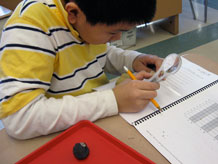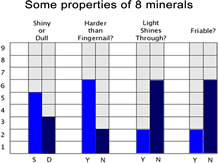What can we learn about minerals by observing them carefully?
4. Make meaning
Purpose of the discussion
Use the discussion as an opportunity to elicit students’ ideas about the difference between rocks and minerals. The aim is for students to recognize how knowing the properties of minerals helps them to identify minerals in their rocks. Use the investigation question, What can we learn about minerals by observing them carefully? as the focus of the discussion.

Engage students in the focus question
To engage students in discussion, distribute the set of four rocks that they used in the last session. Ask students to explore the rocks to identify possible minerals. Color, luster and transparency are some properties that students may find most helpful as they look for evidence of specific minerals.
- Did you find evidence of any of these minerals in the rocks you examined? What properties made you think this mineral was part of the rock?
Provide a few minutes for students to record their ideas and claims in their science notebooks [Can we find some minerals in our rocks?].
Which minerals? It is likely that quartz, mica and biotite will be found in the granite sample, and that feldspar will be found in the basalt. It is possible that none of the eight sample minerals will be seen in the sandstone or conglomerate rocks.
Revisit the investigation question
What can we learn about minerals by observing them carefully?
- How did observing the properties of minerals, help you understand more about rocks?
Summarize the discussion and recap the investigation
Reinforce these ideas:
- When we look at minerals carefully, we can discover some of their properties — including color, luster, hardness, translucence, and friability.
- These properties can help us find even small quantities of particular minerals in rocks.
- Minerals are the materials that rocks (objects) are made of
(optional) Plot data

If time permits, compare the results by recording the data in the histograms you prepared before class. Students can also record this information in their science notebooks [Some properties of 8 minerals]. Note that "Color" cannot be plotted on a 2-column histogram, but you can list the colors separately.
Encourage students to help you transfer the data from the class list or notebooks to the histograms.
How many minerals are shiny?
As the data are compiled, check that students understand how to read the graphs:
Are these minerals mostly hard or mostly soft? Can you back up your claim?



